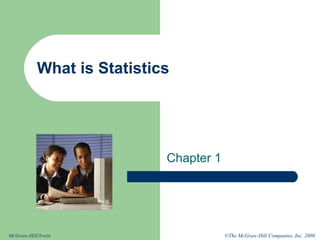
Chapter 01
- 1. What is Statistics Chapter 1 McGraw-Hill/Irwin ©The McGraw-Hill Companies, Inc. 2008
- 2. GOALS Understand why we study statistics. Explain what is meant by descriptive statistics and inferential statistics. Distinguish between a qualitative variable and a quantitative variable. Describe how a discrete variable is different from a continuous variable. Distinguish among the nominal, ordinal, interval, and ratio levels of measurement. 2
- 3. What is Meant by Statistics? Statistics is the science of collecting, organizing, presenting, analyzing, and interpreting numerical data to assist in making more effective decisions. 3
- 4. Who Uses Statistics? Statistical techniques are used extensively by marketing, accounting, quality control, consumers, professional sports people, hospital administrators, educators, politicians, physicians, etc... 4
- 5. Types of Statistics – Descriptive Statistics Descriptive Statistics - methods of organizing, summarizing, and presenting data in an informative way. EXAMPLE 1: A Gallup poll found that 49% of the people in a survey knew the name of the first book of the Bible. The statistic 49 describes the number out of every 100 persons who knew the answer. EXAMPLE 2: According to Consumer Reports, General Electric washing machine owners reported 9 problems per 100 machines during 2001. The statistic 9 describes the number of problems out of every 100 machines. Inferential Statistics: A decision, estimate, prediction, or generalization about a population, based on a sample. 5
- 6. Population versus Sample A population is a collection of all possible individuals, objects, or measurements of interest. A sample is a portion, or part, of the population of interest 6
- 7. Types of Variables A. Qualitative or Attribute variable - the characteristic being studied is nonnumeric. EXAMPLES: Gender, religious affiliation, type of automobile owned, state of birth, eye color are examples. B. Quantitative variable - information is reported numerically. EXAMPLES: balance in your checking account, minutes remaining in class, or number of children in a family. 7
- 8. Quantitative Variables - Classifications Quantitative variables can be classified as either discrete or continuous. A. Discrete variables: can only assume certain values and there are usually “gaps” between values. EXAMPLE: the number of bedrooms in a house, or the number of hammers sold at the local Home Depot (1,2,3,…,etc). B. Continuous variable can assume any value within a specified range. EXAMPLE: The pressure in a tire, the weight of a pork chop, or the height of students in a class. 8
- 9. Summary of Types of Variables 9
- 10. Four Levels of Measurement Nominal level - data that is Interval level - similar to the ordinal classified into categories and level, with the additional cannot be arranged in any property that meaningful particular order. amounts of differences between EXAMPLES: eye color, gender, data values can be determined. religious affiliation. There is no natural zero point. EXAMPLE: Temperature on the Fahrenheit scale. Ordinal level – involves data arranged in some order, but the Ratio level - the interval level with differences between data an inherent zero starting point. values cannot be determined or Differences and ratios are are meaningless. meaningful for this level of EXAMPLE: During a taste test of measurement. 4 soft drinks, Mellow Yellow EXAMPLES: Monthly income was ranked number 1, Sprite of surgeons, or distance number 2, Seven-up number traveled by manufacturer’s 3, and Orange Crush number 4. representatives per month. 10
- 11. Summary of the Characteristics for Levels of Measurement 11
- 12. End of Chapter 1 12
